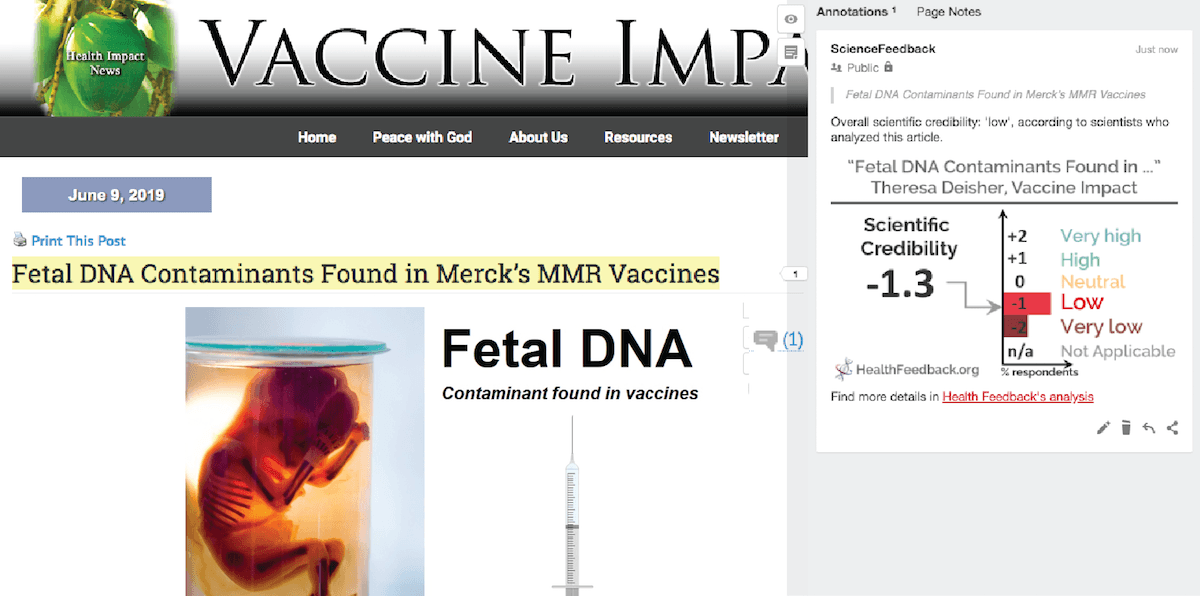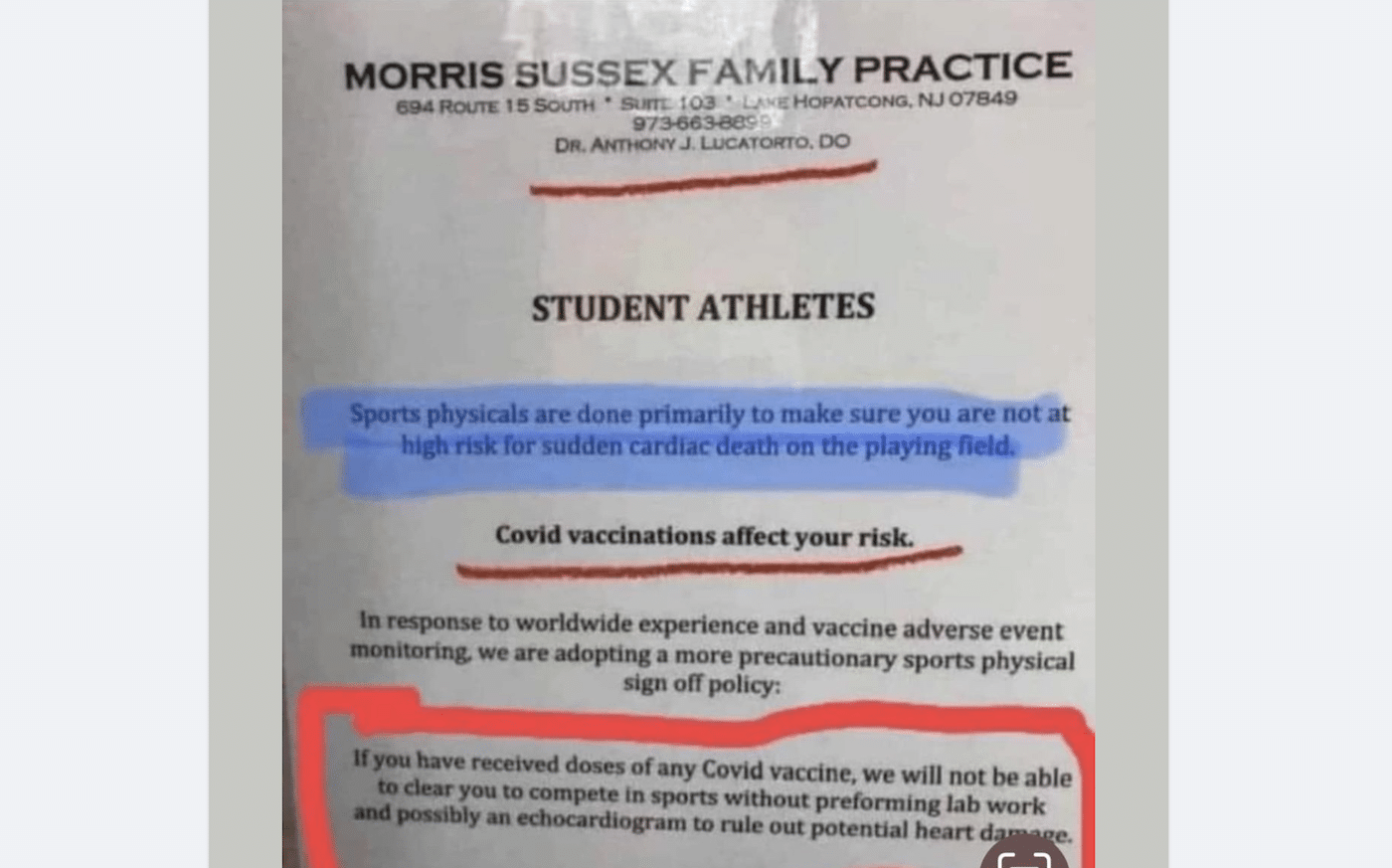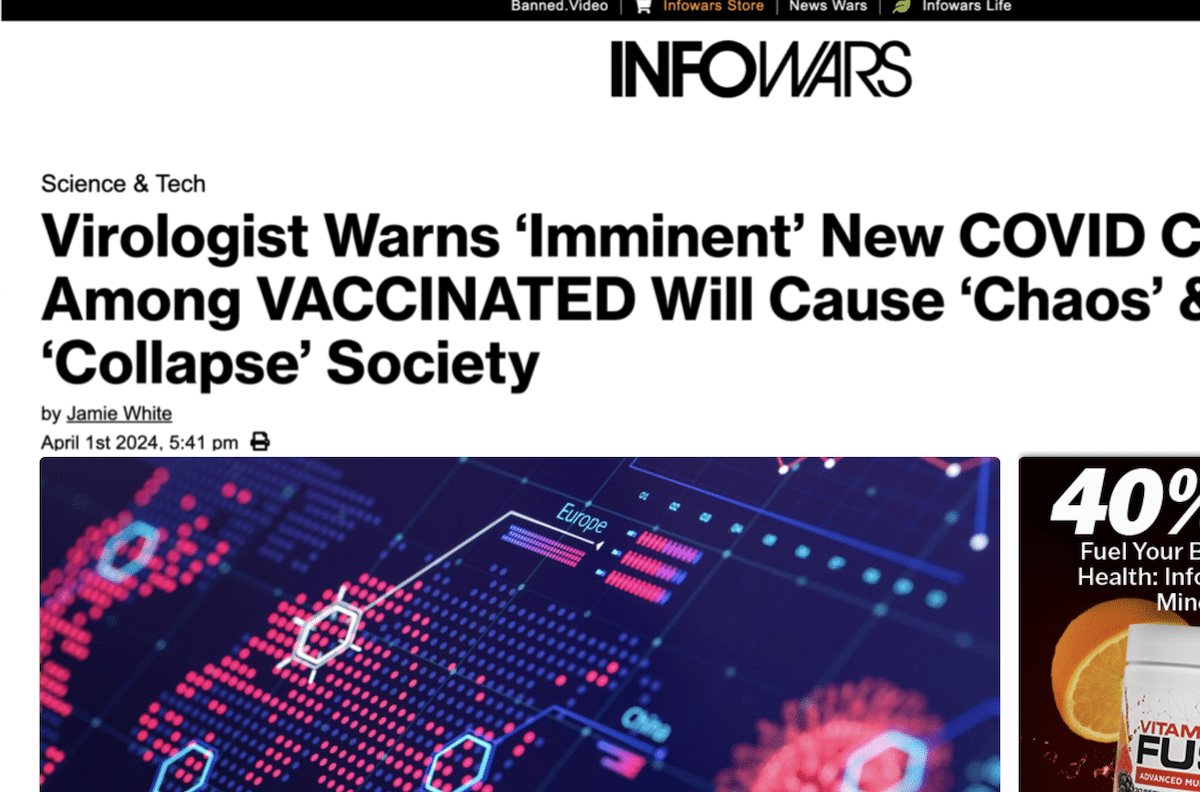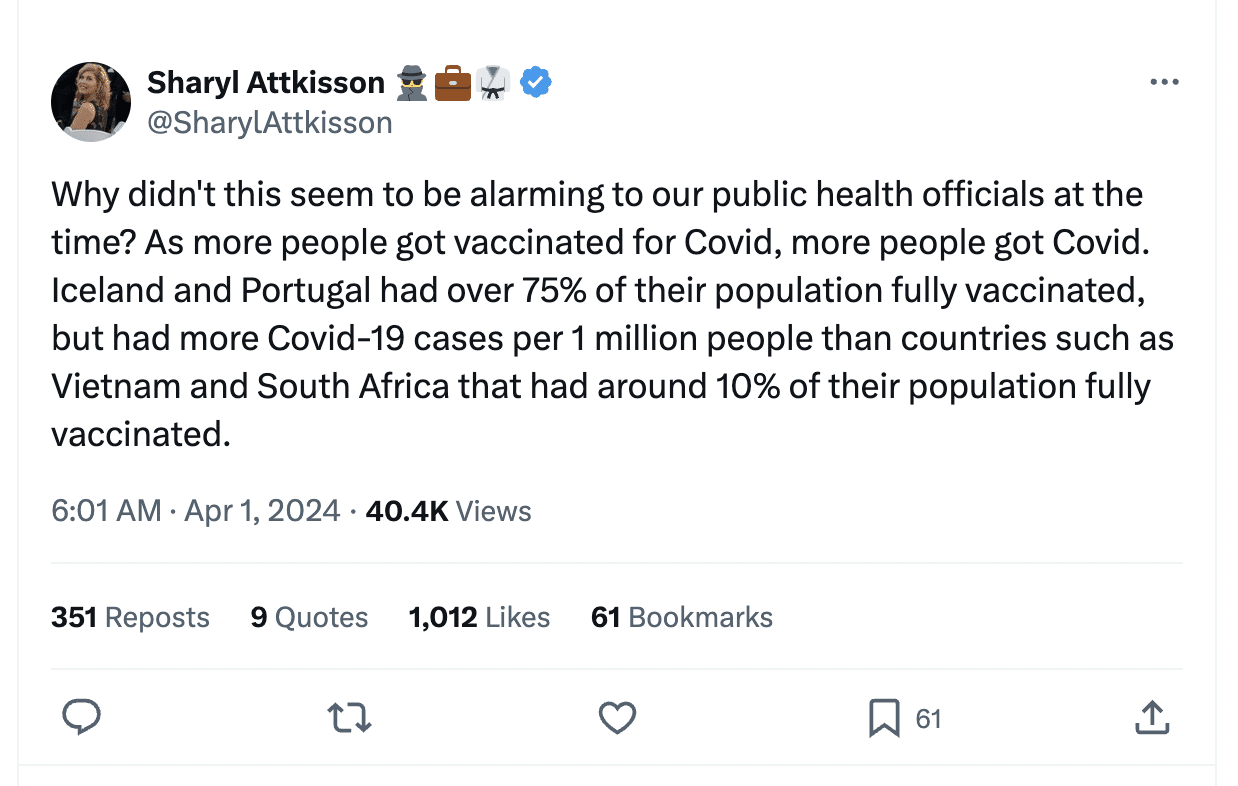- Health
Article claiming vaccines cause autoimmunity and autism due to fetal DNA contaminants found unsupported and implausible
Reviewed content

Headline: "Fetal DNA Contaminants Found in Merck’s MMR Vaccines"
Published in Vaccine Impact, by Theresa Deisher, on 2019-05-19.

Scientists’ Feedback
SUMMARY
This article by Vaccine Impact, published on 19 May 2019 and shared more than 13,000 times, reproduces an open letter written by Dr. Theresa Deisher to legislators about the purported dangers of fetal DNA in vaccines produced with fetal-derived cell lines. The letter claims to discuss “unrefuted scientific facts about fetal DNA contaminants in the MMR vaccine”, founded in large part on a study co-authored by Dr. Deisher herself[1].
Immunologists who reviewed the open letter found its claims to be unsupported and implausible. They acknowledged that certain vaccines are produced using human fetal-derived cell lines, but pointed out that the study of Deisher et al. does not actually demonstrate that fetal DNA is present in vaccines, let alone in a high concentration, having methodological problems that call into question its findings.
While the letter provides a reference list that appears to lend support to its claims, a closer examination shows that the citations are not used appropriately, being misinterpreted or taken out of context.
Nevertheless, the letter maintains the assumption that high levels of fetal DNA are present in vaccines, coupling it with the fact that Toll-like Receptor (TLR) 9 activates a proinflammatory response upon sensing DNA to claim that fetal DNA in vaccines causes autoimmunity. While it is true that TLR9 is involved in autoimmune diseases, reviewers also explain that TLR9 senses only unmethylated DNA (like that of bacteria and viruses), whereas human DNA would be methylated. This means that even if fetal DNA was present – which was not even proven by Deisher et al. to begin with – it would not be able to activate TLR9 anyway.
They also point out that it is implausible for homologous recombination of fetal DNA after vaccination to cause autoimmunity and autism, since it necessitates a chain of events that are extremely unlikely to happen all together, especially in the biological context of a living person and not the artificial environment of a test tube. Another problem with the claim of insertational mutagenesis is the fact that pregnant women, who have higher levels of circulating fetal DNA constantly over 9 months, do not have a higher incidence of cancer. It is therefore unlikely that mutagenesis would occur in children after vaccination – an event that is spread out over several periods – with much lower amounts of fetal cell line-derived DNA.
You can read the original article here.
REVIEWERS’ OVERALL FEEDBACK

Senior Research Fellow, A*STAR Infectious Diseases Labs
Several vaccines are produced using human fetal cell lines. That’s true. But the statement that fetal DNA is found in high quantity in those vaccines is not substantiated. The author of this article, Theresa A. Deisher, cites her own publication (promoting the existence of a link between vaccines and autism as well)[1] to justify this statement but it is good to know that this publication made other scientists sceptical about the method and the results obtained.
It is also good to remember that another publication postulating the same kind of link (the sadly well-known article from Andrew Wakefield) was fraudulent and finally retracted[2].
To justify the induction of autoimmunity in vaccinated children, the author takes the example of a mechanism happening during pregnancy: the activation of an immune receptor by fetal DNA during labour. This context is so far removed from the context of vaccination that it makes no sense to compare them.
Finally, it is also unlikely that fetal DNA fragments could elicit autoimmunity. Our immune system will only react to foreign or altered proteins. Therefore, it would mean that the fragments of DNA have to undergo recombination in the cell, be inserted in a way that gives rise to an altered protein, and what’s more, this has to be done in a huge number of cells to get a significant amount of proteins able to elicit an immune response. Even if not impossible, it is highly improbable that all these events happen at the same time.

Postdoctoral Research Fellow, National University of Singapore
First, a little introduction: to produce vaccines with an attenuated virus like the measles vaccine, it is necessary to produce the viruses first. Viruses, unlike other organisms, require cells to proliferate. The virus needs to infect a cell and hijack the cell machinery to produce its own proteins and replicate its own nucleic acids. Those viruses are produced in an immortalized cell line [some are in fetal-derived lines, some in immortalized epithelial lines (cells lining our digestive tract, skin etc.)]. So it is basically normal to use cell lines for virus production – this is nothing new and most of all, it is nothing out of the ordinary or secret (the names of these lines are MRC5 and WI38).
The author of this letter combines the role of Toll-like Receptor (TLR) 9 in the immune system with the “paper” of Deisher et al.[1] to support the main claim for dangers posed by the vaccine. In fact, TLR9 is a intracellular receptor that detects unmethylated CpG sequences, while human DNA is methylated and therefore cannot activate TLR9. The letter cherry-picks studies, then misinterprets and overstates their results to support its claims. One of these studies shows that hypomethylated fetal DNA activates TLR9 in vitro, and its results suggest that in the mouse model (but not in humans), TLR9 activation by fetal DNA may cause fetal loss in preterm birth[3]. Another is a study suggesting that fetal DNA increases in maternal plasma with the pregnancy, until when, at the end of the pregnancy it may stimulate the immune system to prepare the mother’s body for childbirth[4].
Deisher’s study cited as the main reference for the letter’s claim is simply nonsense and would deserve a debunking of its own, but luckily there are people who have debunked that paper better than I could, statistically and from the point of view of molecular biology. But more to the point: Deisher et al. found approximately 250 nanograms (ng) of single-stranded DNA and around 40 ng of double-stranded DNA in the vaccine vial analysed. She says that the cells take up the DNA and integrate it. To support her hypothesis, she uses Cot1 DNA as a reference DNA. The study actually shows no experimental data that support the claims. They report that the cells are taking up Cot1 based on an experiment in which they co-cultured 107 cells in a few mL of culture media with 500 ng of DNA for 24 – 48 hours and observed that some of the DNA was taken up by the cells. This is obvious: with such a high concentration, cells will take up almost anything. Even if there is such a concentration of DNA in the vaccine (and there is not), the claim is still unreliable in saying that such DNA integrates in the patient’s cells.
To analyse the integration, the authors looked for repeated sequences present in the Cot1 DNA, called Alu sequences, in the co-cultured cells and, not surprisingly found them. Alu sequences are quite easily found in the human genome so this does not indicate integration. The researcher also suggests that DNA is homologously recombined. This is obviously false and unreal, and is wrong also in the letter that uses the study of Deisher et al. as a reference. To do that, the DNA has to go into the bloodstream (consider that vaccines are injected intramuscularly or subcutaneously, not intravenously), travel towards the central nervous system, pass the blood-brain barrier, reach the neurons in such a concentration that would be taken up by the cells, pass through the cell membrane, enter the nucleus and finally undergo homologous recombination, causing an non-specific mutation that will cause autism (a condition that has been shown to have a genetic cause[5,6,7] and that develops during pregnancy[8,9]).
The claims are so biologically and immunologically wrong that the entire letter is just a condensed list of fake claims and fear mongering that can be dangerous when read by someone that does not understand biology.

Research Scientist, Singapore Immunology Network
While the letter provides some concerns about the fetal cell-derived DNA contamination in vaccines, it does not provide any actual evidence to support the claims made. The whole hypothesis of the author (which is misleadingly presented as fact) is based on the author’s own measurements of fetal cell-derived DNA[1], which has serious methodological problems that could be easily prevented by RNase treatment[10]. Additionally, the measurements should have been validated by a different method (e.g. qPCR, capillary gel electrophoresis) and ideally by an independent researcher/institution.
The author equates fetal cell-derived DNA that is a contaminant of vaccine production to cell-free fetal DNA (cff-DNA), which is present in maternal blood during gestation. The latter is valuable for non-invasive prenatal diagnostic[4] and increases with gestational age and with some pregnancy complications (e.g. preterm birth, preeclampsia)[11].
It has been hypothesized that the increase in cff-DNA at term could activate TLR9 on maternal cells, cause immune activation and induce birth[12]. To date, only one study has shown that fetal DNA in very high concentrations (300 μg/mouse, which would be equivalent to approximately 36 mg for a 3 kg infant; while the concentrations Deisher measured were in the range of 20-850 ng/vial) triggered a TLR9-dependent inflammatory reaction that resulted in spontaneous preterm birth[3].
While this is an interesting observation which merits further research, it is not clear how this mechanism would be relevant for an infant or child getting an immunization. Firstly, an immunization is a single event (or multiple events separated by a certain amount of time in the case of boosters), while full-term pregnancy lasts for 9 months. It is reported that, at least in normal pregnancies, cff-DNA is quickly cleared after delivery[4]. Secondly, cff-DNA is believed to derive from the placenta and placental trophoblasts as they undergo cellular apoptosis and necrosis during gestation[13]. There is currently no data available to support that residual DNA derived from fetal fibroblastic cell lines grown in vitro during vaccine production would resemble in vivo-generated fetal DNA derived from the placenta.
Additionally, human DNA is largely non-immunogenic and does not bind TLR9 unless it forms complexes with antibodies and other molecules such as LL-37 or HMGB1[14]. There is evidence that DNA from human placentas is hypomethylated[15] and thus could activate TLR9, but again there is no evidence that the DNA derived from fibroblastic fetal cell lines would resemble human placental DNA. The evidence presented by Dr. Deisher does not support the her claim that the fetal DNA contamination present in a vaccine would lead to the development of autoimmune disease.
Human diploid cell strains, such as MRC-5 and WI-38 cells are regarded as safe, as they have been derived from normal fetuses, have a stable karyotype and and do not cause tumors when injected in experimental animals[16,17,18]. The reference claiming that as low as 1.9 ng/mL of DNA fragments results in insertion into the genome of stem cells is misleading, since all donor DNA were 5′ and 3′ end protected by three phosphorothioate internucleoside linkages[19], which would make them resistant to nucleases and persist longer in the mice. This is not a valid comparison to fetal cell line-derived DNA, which is normal fragmented genomic DNA. If Dr. Deisher predicts insertional mutagenesis of low amounts of fetal cell line-derived DNA from vaccines into a child’s DNA, how does she explain that pregnancy does not cause cancer, since pregnant women are exposed to higher amounts of fetal DNA over a period of 9 months (even multiple times if they have multiple pregnancies)? From this point of view, the hypothesis of fetal human DNA being mutagenic does not seem plausible.
Annotations
The statements quoted below are from the article; comments are from the reviewers (and are lightly edited for clarity).
“Fetal DNA contaminants in vaccines are not in low innocuous amounts. They are a very strong proinflammatory trigger.“

Postdoctoral Research Fellow, National University of Singapore
Fetal DNA could activate the immune system, and it seems to happen during late-stage pregnancy or miscarriage, but no proof exists that DNA contained in the vaccines (if any) causes any reaction, particularly since the adjuvant present in the vaccine is supposed to stimulate and elicit a stronger inflammatory response with activation of TLR3 (with poly:IC) or TLR7 (with aluminium salts). The concentration shown has never been observed in the analysis presented to the EMA (European Medical Association) or the FDA.

Research Scientist, Singapore Immunology Network
Merck’s MMR II vaccine contains live attenuated rubella virus propagated in WI-38 human diploid lung fibroblasts. Dr. Deisher states in her letter that the vaccine is heavily contaminated with human fetal DNA from the production process, however she provides no reference for this claim. Additionally, the author states in the letter that levels in the children can reach up to 5 ng/mL after vaccination, but again she doesn’t provide any reference or methods that were used for these measurements.
“To illustrate the autoimmune capability of very small amounts of fetal DNA, consider this: labor is triggered by fetal DNA from the baby that builds up in the mother’s bloodstream, triggering a massive immune rejection of the baby“

Postdoctoral Research Fellow, National University of Singapore
Yes, the fetal DNA can have this interaction with the pregnant mother. There are several studies and researchers who are studying the interaction of the maternal immune system with the fetus, but all these studies have nothing to do with the vaccines, since the immune system of the child vaccinated is totally different from the one of a pregnant woman or the one of the fetus[20,21].

Research Scientist, Singapore Immunology Network
Fetal DNA fragments are important for noninvasive prenatal diagnostics[4] and are known to be increased in maternal blood in association with pregnancy complications such as early pregnancy loss, preeclampsia, fetal growth restriction and preterm labour[11,12]. The paper that Dr. Deisher uses as a reference[22] is actually an article about a hypothesis and theory, which states that “a modification occurs in late pregnancy leading to an acute inflammatory response driven by proinflammatory cytokines, hormones, and chemokines, which traffic effector leukocytes to the myometrium and initiate labor[23]. The exact mechanism as to how labor is initiated in human beings remains unclear.”
“Injecting our children with human fetal DNA contaminants bears the risk of causing two well-established pathologies: insertational mutagenesis and autoimmune disease“

Postdoctoral Research Fellow, National University of Singapore
Insertional mutagenesis is caused by integrating viruses of which no trace was found in any vaccine[21], so the claim is false.

Research Scientist, Singapore Immunology Network
The immune system has evolved to not recognise self-nucleic acids (DNA and RNA) as this would provoke an autoimmune response. Cells are able to internalize microbes and deliver them to designated endosomal regions, where their nucleic acids can interact with the designated receptors TLR3, TLR7/8 and TLR9 and provoke an immune response[24]. This intracellular (endosomal) localization protects the cells from the recognition of self-nucleic acids and thus prevents autoimmune reactions[25,26].
Only in certain scenarios, such as in the autoimmune disease systemic lupus erythematosus, are specific components present in the blood of the patients (antibodies, LL-37, HMGB1) that bind to nucleic acids and increase their uptake into the cells[14]. Dr. Deisher is suggesting a TLR9-dependent mechanism for recognition of fetal cell-derived DNA, however we and others have shown that TLR9 signaling has, at least in mice, a protective role in autoimmunity[14,27,28].
REFERENCES
- 1 – Deisher et al. (2015) Epidemiologic and Molecular Relationship Between Vaccine Manufacture and Autism Spectrum Disorder Prevalence. Issues in Law & Medicine. (A critique of the study can be found at Science-Based Medicine.)
- 2 – Wakefield et al. (1998) Retraction Notice: Ileal-lymphoid-nodular hyperplasia, non-specific colitis, and pervasive developmental disorder in children. The Lancet.
- 3 – Scharfe-Nugent et al. (2012) TLR9 provokes inflammation in response to fetal DNA: mechanism for fetal loss in preterm birth and preeclampsia. Journal of Immunology.
- 4 – Lo et al. (1998) Quantitative analysis of fetal DNA in maternal plasma and serum: implications for noninvasive prenatal diagnosis. American Journal of Human Genetics.
- 5 – Klauck (2006) Genetics of autism spectrum disorder. European Journal of Human Genetics.
- 6 – Sebat et al. (2007) Strong Association of De Novo Copy Number Mutations with Autism. Science.
- 7 – Brandler et al. (2018) Paternally inherited cis-regulatory structural variants are associated with autism. Science.
- 8 – Stoner et al. (2014) Patches of Disorganization in the Neocortex of Children with Autism. New England Journal of Medicine.
- 9 – Von Ehrenstein et al. (2019) Prenatal and infant exposure to ambient pesticides and autism spectrum disorder in children: population based case-control study. British Medical Journal.
- 10 – Shen et al. (2013) Size analysis of residual host cell DNA in cell culture-produced vaccines by capillary gel electrophoresis. Biologicals.
- 11 – Van Boeckel et al. (2018) Cell-free fetal DNA and spontaneous preterm birth. Reproduction.
- 12 – Phillippe (2014) Cell-free fetal DNA–a trigger for parturition. New England Journal of Medicine.
- 13 – Sekizawa et al. (2003) Cell-free fetal DNA in the plasma of pregnant women with severe fetal growth restriction. American Journal of Obstetrics and Gynecology.
- 14 – Celhar et al. (2012) TLR7 and TLR9 in SLE: when sensing self goes wrong. Immunology Research.
- 15 – Yuen et al. (2010) DNA methylation profiling of human placentas reveals promoter hypomethylation of multiple genes in early-onset preeclampsia. European Journal of Human Genetics.
- 16 – Jacobs et al. (1970) Characteristics of a Human Diploid Cell Designated MRC-5. Nature.
- 17 – Jacobs (1976) Updated results on the karyology of the WI-38, MRC-5 and MRC-9 cell strains. Developments in Biological Standardization.
- 18 – Petricciani et al. (1976) Safety of Viral Vaccine Cell Substrates: A Reevaluation. Journal of the National Cancer Institute.
- 19 – McNeer et al. Systemic delivery of triplex-forming PNA and donor DNA by nanoparticles mediates site-specific genome editing of human hematopoietic cells in vivo. Gene Therapy.
- 20 – Bao et al. (2016) Toll-like Receptor 9 Can be Activated by Endogenous Mitochondrial DNA to Induce Podocyte Apoptosis. Scientific Reports.
- 21 – Switzer et al. (2011) No evidence of murine leukemia virus-related viruses in live attenuated human vaccines. PLoSOne.
- 22 – Enninga et al. (2015) Immune Reactivation by Cell-Free Fetal DNA in Healthy Pregnancies Re-Purposed to Target Tumors: Novel Checkpoint Inhibition in Cancer Therapeutics. Frontiers in Immunology.
- 23 – Peltier (2003) Immunology of term and preterm labor. Reproductive Biology and Endocrinology.
- 24 – Blasius and Beutler (2010) Intracellular toll-like receptors. Immunity.
- 25 – Barton et al. (2006) Intracellular localization of Toll-like receptor 9 prevents recognition of self DNA but facilitates access to viral DNA. Nature Immunology.
- 26 – Yasuda et al. (2005) Endosomal translocation of vertebrate DNA activates dendritic cells via TLR9-dependent and -independent pathways. Journal of Immunology.
- 27 – Nickerson et al. (2010) TLR9 regulates TLR7- and MyD88-dependent autoantibody production and disease in a murine model of lupus. Journal of Immunology.
- 28 – Christensen et al. (2010) Toll-like receptor 7 and TLR9 dictate autoantibody specificity and have opposing inflammatory and regulatory roles in a murine model of lupus. Immunity.
Notes:
[1] See the rating guidelines used for article evaluations.
[2] Each evaluation is independent. Scientists’ comments are all published at the same time.



